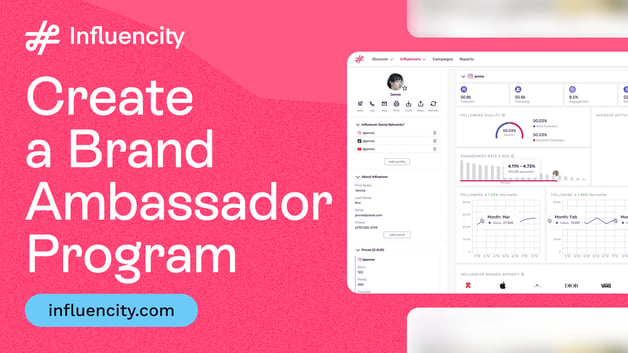What are the most important social media KPIs | Influencity
Launching marketing actions on social media can be very beneficial for establishing valuable relationships with your target audience, but can also be extremely useful for increasing sales, boosting social reach and improving your ROI.
A KPI (Key Performance Indicator) is a reliable indicator of a campaign’s performance. Nowadays, it’s possible to quantify and measure hundreds of different types of social media data, but it’s important to make note of which data is valuable for each specific case. In this article, we’re going to take a look at and analyse the main social media KPIs that we should be taking into account if we want our marketing actions to be successful and our ROI as high as possible.
What are social media KPIs
Social media KPIs are key pieces of data that tell you not only how your campaign is performing on social networks, but also the profit it’s generating, as well as indicating which campaign actions are working best and whether or not you’re reaching your objectives.
When launching campaigns on social networks, aside from increasing your followers or the number of likes your posts get, the most important thing is for your content to be reaching potential clients, impacting a wider audience and boosting brand image in the eyes of the public.
Social media KPIs are great for providing brands with valuable information, such as the following:
- If posts are reaching the target audience
- If the audience is reacting in a certain way to campaign content
- If followers are showing interest and asking questions about the product or service
- How many users end up converting to clients
Social network KPIs you should measure and monitor
There are four main social network KPIs that all brands should be aware of: engagement, reach, leads/conversions and clients. But, what do they all mean?
1.- Engagement
Engagement is an imperative metric for any marketing action carried out on social networks and is often considered the most important of the social media KPIs.
Engagement can be defined as the rate of interaction generated by campaign content, which is what distinguishes it from social reach and makes it a great metric for measuring campaign success.
To measure engagement, you should pay close attention to the following metrics:
- This is the most elementary way to calculate the level of interest your content is generating amongst your audience.
- Measuring likes is an excellent way to evaluate how the audience are receiving your campaign content.
- Quality content will quite often be shared by your followers, and those who share a brand’s content are more likely to recommend its products.
- This is another great indicator of how your audience is reacting to content.
- Other forms of reactions. These are more valuable metrics than likes, since they require more effort on behalf of the user.
- Brand mentions. Measuring brand mentions lets you know when are where users are talking about your company.
2.- Reach
Your campaign reach indicates how many people have been impacted by your marketing strategy on social networks. It can be determined by the following metrics:
- This social media KPI indicates how many times your content has appeared on a follower’s timeline and how many times they’ve viewed it.
- With this KPI, you can see the percentage of web traffic generated by different social media channels.
3.- Leads and conversions
A brand may have a high number of followers on Instagram who frequently like their posts, but it’s sometimes hard to convert this engagement into sales. Instagram KPIs are therefore extremely useful for helping brands find leads and convert potential clients.
- Measuring the number of potential clients impacted as well as client conversion rates is essential because the final goal of any campaign is to increase sales.
- There are several tools that can help you do so, such as Google Analytics or HubSpot. Thanks to these tools, we can see how many visits, unique visits, and individual page visits your website has received as well as the bounce rate and other more advanced KPIs, such as search traffic and registered users.
4.- Clients
When your objective is to increase sales, if you don’t measure the number of final clients achieved via your social media strategy, you won’t know which of your campaign’s actions were the most beneficial.
If you managed to impact your target audience and encourage them to engage with the brand, they will more than likely be interested in purchasing the product or service. To find out how your web visitors arrived at your site or via which medium they discovered your brand, see your audience’s demographic, what they’re interested and what they follow, you can use trackable links, unique discount and UTM codes.
Other digital marketing KPIs
ROI (Return on investment)
When your main objective is to increase sales, ROI is an indispensable KPI, since it measures the cost of each campaign action. When calculating the ROI of a digital marketing campaign make sure you do the following:
- Establish a budget
- Determine the cost of each marketing action
- Define targets from the outset
- Plan everything in a consistent manner.
The formula used to work out the ROI of a social media action is: (Campaign profit – cost)/cost) x 100
CPC
CPC or Cost per Click is paid each time a user clicks on an ad. The CPC is calculated by dividing the total cost by the number of clicks, multiplying the conversion rate by cost per marketing action (CPA), or dividing the CPM (Cost per Mille) by 1000 and dividing the result by the CTR (Click Through Rate).
CPC = Cost/Clicks
(CPM / 1000)/CTR
CTR
Another important KPI is CTR (Click Through Rate), which is calculated with the following formula:
(number of clicks over a period of time/ total impressions from that period) x 100
The CTR indicates the click rate of the links published by influencers on social media.
CPL
The CPL (Cost per Lead) reveals the cost of each potential client conversion and is calculated with the following formula:
(Campaign cost/total number of potential clientes gained) x 100
Influencer Marketing KPIs
Although there are numerous useful KPIs for different types of marketing strategies, with Influencer Marketing, the following are essential metrics:
- Engagement: With influencer marketing campaigns, the engagement rate represents the relationship between the number of interactions with a post and the total audience.
- Social Reach: the potential reach of the influencers participating in a campaign.
- Earned Media: all of the organic communication generated around the brand as a result of campaign actions with influencers (comments, likes, retweets, mentions, etc).
Now that you know the main social media KPIs, as well as those which are essential for Influencer Marketing, find out how to measure them by reading our free Ebook “Influencer Marketing KPIs you should measure and control”.
Tags:




















%20and%20How%20Can%20They%20Benefit%20Your%20Brand%20article.jpg?length=628&name=What%20Are%20Key%20Opinion%20Leaders%20(KOL)%20and%20How%20Can%20They%20Benefit%20Your%20Brand%20article.jpg)








